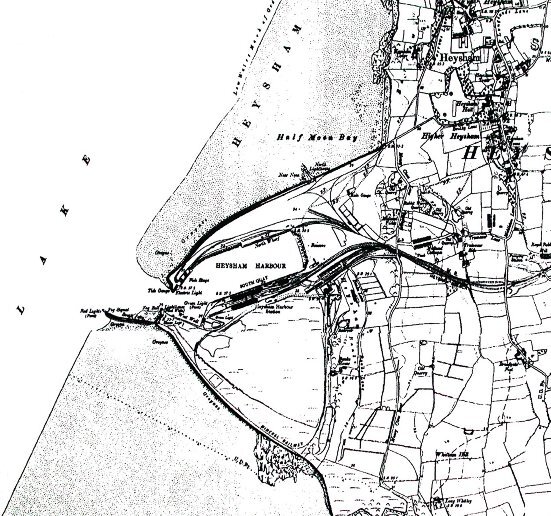By 1850 the Little North Western Railway had opened a railway from Leeds to Morecambe, via Settle and Lancaster. This railway was taken over by the Midland Railway in 1871, giving the Midland access to the harbour at Morecambe. In the 1860s, the Midland Railway Company entered an agreement with Furness Railways for its Northern Ireland passenger service to Piel - served by the Furness Railway. Despite the initial success of this partnership however, the Midland Railway Company decided to develop its own port at Heysham where deep-water access was more reliable. In 1865 there was an Act of Parliament entitled Heysham Railway and Pier Bill. It was over 30 years later, in 1897, when the Midland Railway Company purchased land for the construction of the new harbour and railway link. Their contractors, Price & Wills (harbour) and Godfrey & Liddelow (railway) began construction in the same year. By 1898, there were about 200 men employed and this figure soon reached approximately 2,000.
Workers (navvies, short for navigators) were housed in two wooden 'villages' known as Klondyke and Dawson City, (named after a river and a town in the area of the North American gold rush which had started in 1896). The Midland Railway archives from 1897 appear to reveal a navvy village on the site of the present Trumacar schools..
The harbour extended out from the headlands Near Naze in Half Moon Bay and Red Nab rocks (bottom centre of map) with two substantial sea walls to a narrow mouth just short of the deep water channel shown on the map as (Heysham) ‘Lake’.
Two distinct areas were enclosed, the roughly rectangular Harbour basin itself about 800m long by 200m wide and a large triangular area accessed by a lock from the south side of the harbour basin near the harbour entrance. This area had been and intended to be both a wet and dry dock but never developed. Eventually it became known as the Dry Dock despite a substantial area of it being a freshwater pool as can be seen in the photograph below.

For an 1898 extract for the Visitor newspaper describing the early works at the harbour click here.
Heysham Harbour was officially opened by the Midland Railway Company in 1904 with direct rail connection, and four new steamers (Antrim, Donegal, Londonderry and Manxman) were built to open services to Belfast and Douglas. The port was bought by the Mersey Docks and Harbour Board in 2001, which was in turn bought and merged with Peel Ports in 2005. Peel Ports are the current operators of the harbour.
Today the passenger ferries are mainly to the Isle of Man and operated by the Isle of Man Steam Packet Company, which dates from 1830 and is the oldest continuously operating passenger shipping company in the world.
The present Isle of Man ferry, which entered service in 2012, is the Manxman and is the third vessel to hold the name. Other companies which operate regular freight services from the port are Seatruck and Stena Line. These sail from Heysham to Northern Ireland.

